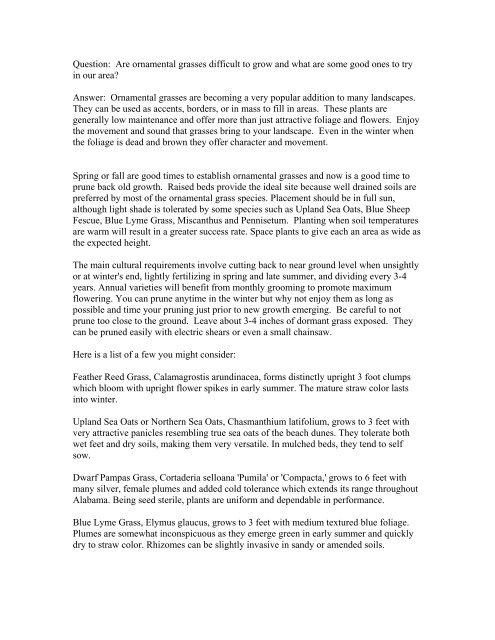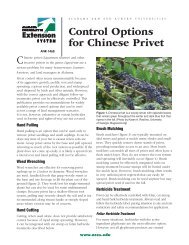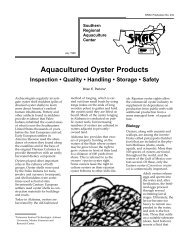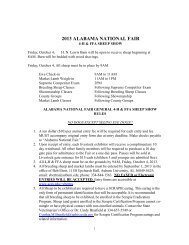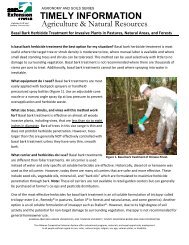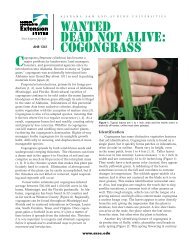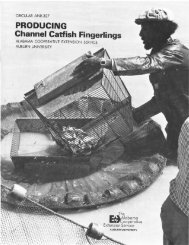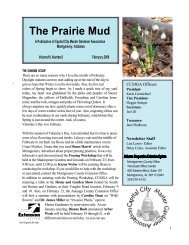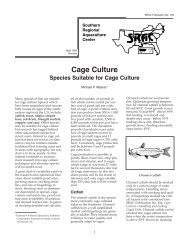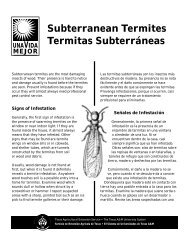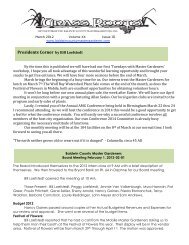Ornamental Grasses - Alabama Cooperative Extension System
Ornamental Grasses - Alabama Cooperative Extension System
Ornamental Grasses - Alabama Cooperative Extension System
You also want an ePaper? Increase the reach of your titles
YUMPU automatically turns print PDFs into web optimized ePapers that Google loves.
Question: Are ornamental grasses difficult to grow and what are some good ones to try<br />
in our area?<br />
Answer: <strong>Ornamental</strong> grasses are becoming a very popular addition to many landscapes.<br />
They can be used as accents, borders, or in mass to fill in areas. These plants are<br />
generally low maintenance and offer more than just attractive foliage and flowers. Enjoy<br />
the movement and sound that grasses bring to your landscape. Even in the winter when<br />
the foliage is dead and brown they offer character and movement.<br />
Spring or fall are good times to establish ornamental grasses and now is a good time to<br />
prune back old growth. Raised beds provide the ideal site because well drained soils are<br />
preferred by most of the ornamental grass species. Placement should be in full sun,<br />
although light shade is tolerated by some species such as Upland Sea Oats, Blue Sheep<br />
Fescue, Blue Lyme Grass, Miscanthus and Pennisetum. Planting when soil temperatures<br />
are warm will result in a greater success rate. Space plants to give each an area as wide as<br />
the expected height.<br />
The main cultural requirements involve cutting back to near ground level when unsightly<br />
or at winter's end, lightly fertilizing in spring and late summer, and dividing every 3-4<br />
years. Annual varieties will benefit from monthly grooming to promote maximum<br />
flowering. You can prune anytime in the winter but why not enjoy them as long as<br />
possible and time your pruning just prior to new growth emerging. Be careful to not<br />
prune too close to the ground. Leave about 3-4 inches of dormant grass exposed. They<br />
can be pruned easily with electric shears or even a small chainsaw.<br />
Here is a list of a few you might consider:<br />
Feather Reed Grass, Calamagrostis arundinacea, forms distinctly upright 3 foot clumps<br />
which bloom with upright flower spikes in early summer. The mature straw color lasts<br />
into winter.<br />
Upland Sea Oats or Northern Sea Oats, Chasmanthium latifolium, grows to 3 feet with<br />
very attractive panicles resembling true sea oats of the beach dunes. They tolerate both<br />
wet feet and dry soils, making them very versatile. In mulched beds, they tend to self<br />
sow.<br />
Dwarf Pampas Grass, Cortaderia selloana 'Pumila' or 'Compacta,' grows to 6 feet with<br />
many silver, female plumes and added cold tolerance which extends its range throughout<br />
<strong>Alabama</strong>. Being seed sterile, plants are uniform and dependable in performance.<br />
Blue Lyme Grass, Elymus glaucus, grows to 3 feet with medium textured blue foliage.<br />
Plumes are somewhat inconspicuous as they emerge green in early summer and quickly<br />
dry to straw color. Rhizomes can be slightly invasive in sandy or amended soils.
Ravenna Grass (Hardy Pampas), Erianthus ravennae, is a vigorous clump grass similar in<br />
size to standard Pampas, but lacks the quality of plume but is very cold hardy. I have<br />
had regular Pampas for ten years without severe winter kill but it has been mild for all<br />
that time.<br />
Maiden Grass, Miscanthus sinensis 'Gracillimus,' is perhaps the most popular of the<br />
Japanese Silver Grass group. The upright, arching 5 to 6 foot plants display dark green,<br />
fine textured foliage and rosy plumes in late summer. Flowers mature to silver and persist<br />
through winter. 'Morning Light' is slightly smaller in stature with narrow banded white<br />
variegation along leaf edges.<br />
Porcupine Grass, Miscanthus sinensis 'Strictus,' is an erect form of Zebra Grass. Dramatic<br />
garden accent is provided by golden horizontal bands on upward oriented leaves of the 5<br />
to 6 foot plant. Erect, deep straw colored flowers are prominent from September through<br />
winter.<br />
Dwarf Fountain Grass, Pennisetum alopecuroides, forms dense 2 to 3 foot clumps and is<br />
often confused with annual fountain grass. Plumes appear in midsummer and fade from<br />
rose-brown to deep straw color. Small cultivars usually require a little extra water and<br />
fertilizer for good plant performance.<br />
There are many varieties of each of these and many other species to choose from. For<br />
more information visit the following web site from the University of Georgia:<br />
http://pubs.caes.uga.edu/caespubs/horticulture/orngrass.html<br />
Tony Glover<br />
Regional <strong>Extension</strong> Agent<br />
<strong>Alabama</strong> <strong>Cooperative</strong> <strong>Extension</strong> <strong>System</strong>


